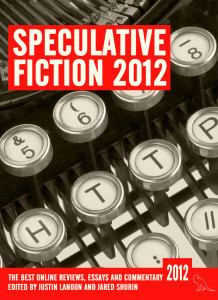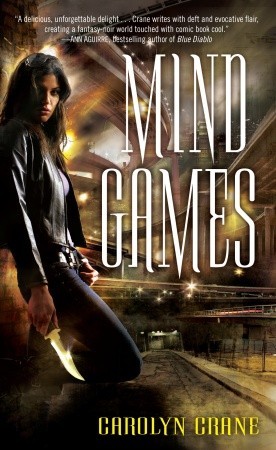Sarah Chorn's Blog, page 104
March 28, 2013
Earth Girl – Janet Edwards
 About the Book
About the Book
2788. Only the handicapped live on Earth. While everyone else portals between worlds, 18-year-old Jarra is among the one in a thousand people born with an immune system that cannot survive on other planets. Sent to Earth at birth to save her life, she has been abandoned by her parents. She can’t travel to other worlds, but she can watch their vids, and she knows all the jokes they make. She’s an ‘ape’, a ‘throwback’, but this is one ape girl who won’t give in.
Jarra invents a fake background for herself – as a normal child of Military parents – and joins a class of norms that is on Earth to excavate the ruins of the old cities. When an ancient skyscraper collapses, burying another research team, Jarra’s role in their rescue puts her in the spotlight. No hiding at back of class now. To make life more complicated, she finds herself falling in love with one of her classmates – a norm from another planet. Somehow, she has to keep the deception going.
A freak solar storm strikes the atmosphere, and the class is ordered to portal off-world for safety – no problem for a real child of military parents, but fatal for Jarra. The storm is so bad that the crews of the orbiting solar arrays have to escape to planet below: the first landing from space in 600 years. And one is on collision course with their shelter.
271 pages (Hardcover)
Published on march 5, 2013
Published by Pyr
Author’s webpage
The publisher sent this book for my review.
You can purchase a copy of this book by clicking on the following links: Earth Girl , Earth Girl – Kindle
, Earth Girl – Kindle
—–
I’ve read a veritable ton of post apocalyptic young adult books. I’ve seen a lot of young adult books involving vampires and werewolves, angels or whatever other supernatural creature you can dream of. One thing I’ve never seen or read before is a young adult science fiction novel. There’s a first for everything, and Earth Girl was my first.
Earth Girl takes place in 2788 where only the handicapped live on Earth. Jarra, our protagonist, is stuck on Earth because her immune system couldn’t handle being on any other planet. Earth is a planet of dead ends. The people who live there only have a few career options open to them. No one really interacts with the people who are handicapped so there are plenty of stereotypes and misunderstandings going around. The handicapped are called “apes,” which is a hurtful term in the best of times. Jarra has quite a bit of anger regarding her situation, so she dreams up a fake past for herself and enters a university history course full of kids from other planets who are studying for a year on Earth. Thus the book begins.
One of the things that Edwards does really well in Earth Girl is address the issue of prejudice. Earth Girl is full of raw emotions that will charge up most readers. It’s easy to imagine yourself in Jarra’s shoes, hurt, upset with how she’s seen, and stuck in a situation she’d rather not be in through an accident of birth. Not only is it easy to feel the emotions that Edwards infuses her book with, but it’s easy to transpose those emotions and thoughts to our own world and time. Jarra has the benefit of being able to tell her story where many of the differently abled in our day and age don’t. Earth Girl serves a duel purpose of raising awareness to a topic that really doesn’t get enough attention.
The story itself is rather fun but very predictable. It follows a sort of paint-by-numbers course and really lacks any surprise or shock value. The romance is obvious as soon as the character becomes introduced to the plot. As things unwind, it’s pretty clear how the big dramatic ending will go. While predictability can get a bit old, the subject matter in Earth Girl is fresh enough to keep the predictability from being too upsetting or disheartening. In fact, it’s easy to overlook because there are so many interesting things to absorb.
Perhaps what disheartened me the most was the characterization, which was sadly lackluster and cookie-cutter. Jarra does everything right. She knows how to work all the machines and can make everyone laugh at her witty remarks. Despite the fact that she’s struggling with her own secrets and demons, she’s just not really that believable. While the author was probably trying to show just how capable a handicapped individual was, there’s a line between capability and unbelievable perfection and the author crossed it. Jarra isn’t just capable, she’s just about perfect and that really takes away from my ability to believe in her.
Furthermore, some things happen throughout the course of the book involving Jarra’s parents, a military ceremony, and a few incidents where Jarra (surprise!) saves the day that really rattled my enjoyment. Too much happens to Jarra in a short period of time. It’s too convenient, and then it’s way too convenient that she somehow rises to the surface in all these situations and becomes, at times, the delivering angel. This convenience, while it works well in the book, really affects the realism and believability in the plot.
Edwards builds a great foundation for Earth Girl. The story is fresh, the setting is unique, the issues dealt with are one of a kind, but somehow a predictable plot and some really unbelievable characters and situations overshadow all of this. Earth Girl is a fun read, and Edwards handles some sensitive issues with real poise, which sets this young adult read in a category all its own. While I might pick on some aspects of this book, it’s worth a read. Edwards is bold and inventive. Earth Girl brings fresh color to a genre that is going stale.
3/5 stars
March 27, 2013
No Return – Zachary Jernigan
 About the Book
About the Book
On Jeroun, there is no question as to whether God exists—only what his intentions are.
Under the looming judgment of Adrash and his ultimate weapon—a string of spinning spheres beside the moon known as The Needle—warring factions of white and black suits prove their opposition to the orbiting god with the great fighting tournament of Danoor, on the far side of Jeroun’s only inhabitable continent.
From the Thirteenth Order of Black Suits comes Vedas, a young master of martial arts, laden with guilt over the death of one of his students. Traveling with him are Churls, a warrior woman and mercenary haunted by the ghost of her daughter, and Berun, a constructed man made of modular spheres possessed by the foul spirit of his creator. Together they must brave their own demons, as well as thieves, mages, beasts, dearth, and hardship on the perilous road to Danoor, and the bloody sectarian battle that is sure to follow.
On the other side of the world, unbeknownst to the travelers, Ebn and Pol of the Royal Outbound Mages (astronauts using Alchemical magic to achieve space flight) have formed a plan to appease Adrash and bring peace to the planet. But Ebn and Pol each have their own clandestine agendas—which may call down the wrath of the very god they hope to woo.
Who may know the mind of God? And who in their right mind would seek to defy him? Gritty, erotic, and fast-paced, author Zachary Jernigan takes you on a sensuous ride through a world at the knife-edge of salvation and destruction, in one of the year’s most exciting fantasy epics.
320 pages (hardcover)
Published on March 5, 2013
Published by Night Shade Books
Author’s webpage
This book was provided for my review by the author.
You can purchase a copy of this book by clicking on the following links: No Return , No Return – Kindle
, No Return – Kindle
—–
No matter what you think of Night Shade Books, they have a long running record of releasing edgy, daring and bold books that end up being a huge success. Night Shade Books has become a cutting edge publishing house with a reputation to match. Nothing they release is typical, and that’s probably the reason why I have a standing policy to read every book that a Night Shade author approaches me with. I can always expect something bold and different. When you read 100-150 books a year, bold and different is very, very important.
No Return is the kind of book that does Night Shade proud. Jernigan has created something quite unique here. It’s not quite fantasy, not quite SciFi, but full of enough grit, sex and cold reality to catch anyone’s attention. However, despite all the in-your-face action, Jernigan is playing with some more subtle, deeper themes. No Return is a book of layers. There’s a lot of fun and a breakneck plot on the surface, but under all the pomp and circumstance is a tale about relationships, identity, and religion. If that’s not enough, Jernigan even toys with sexuality a bit in No Return. Really, there’s something for everyone.
Books that tell stories on multiple levels are the books I tend to enjoy most. On the surface, this is a tale of a few mismatched, headstrong and goal oriented individuals, all vastly unique in their own ways, all working toward their own objectives. There’s plenty of action, plenty of progression and exploration of individuals and their relationships. Nothing is sedentary in Jernigan’s book. Instead, everything is moving – moving forward, moving into orbit, moving across countries, moving on an inner journey, moving in dreams… It’s a constant, and the plot matches that with an energy that’s quite shocking. Jernigan drops the reader into a world that’s in flux and the reader automatically gets pulled along.
There is no slow world building at the start with a wonderful plot at the halfway point. Jernigan builds his world, cultures and peoples as he goes. With a plot as quick moving as this one, you might miss some details that could be important later. There could also be moments with some incredibly unique species where you aren’t quite certain what’s going on, but the plot will carry you along anyway, and time tends to clear up any confusion nicely.
No Return is a hybrid SciFi/Fantay. Books that straddle those two genres are rare, and rarer still is Jernigan’s world. It’s one of a kind; full of people that are just as unique as his world. It would be quite easy for Jernigan to let his world building slide a bit due to his intricate and overwhelming plot, but he doesn’t. His world is well realized and it truly shines. Jernigan focuses his time and energy where it’s important. He builds up interesting species, the likes of which you won’t see anywhere else, and really infuses them with a life of their own. I would have enjoyed a bit more history, and cultural variation to match the species variation, but these are niggling details that most readers probably won’t notice.
The characters are just as unique as the world, each shining in their own way. Perhaps what I enjoyed most was that Jernigan wasn’t afraid of showing his character’s frailties and flaws. The characters in Jernigan’s world get injured. They hurt. They fall in love. They suffer from sexual tension, just like anyone else. Jernigan really isn’t afraid to exploit any of that and work it nicely into his plot. This adds a level of realism that really surprised me in a debut work.
As I mentioned earlier, Jernigan deals with a lot of deeper themes. Issues of divinity, the nature of God and the power of prayer are introduced right in the prologue. It doesn’t take long for Jernigan to prove that he’s not too shy to throw readers into uncomfortable situations regarding violence and sexuality. While these scenes might make some readers squirm, they aren’t frivolous. It all works toward the plot, and builds up the more subtle, thought provoking themes that Jernigan is toying with. No Return is one of those rare books that is a joy to read because of the plot, but it also will leave you thinking. I tend to tip my hat at authors who aren’t afraid to make readers uncomfortable in their journey to explore these deeper themes.
That being said, Jernigan really doesn’t overwhelm his book with preaching, or deeper morals. Instead, he tells a hell of a story and weaves in some thought provoking questions as you go. It is easy to overlook these deeper themes in favor of many of the cool gadgets, situations and species that Jernigan has dreamed up, but they are definitely there if you look for them.
Jernigan has really unleashed something unique on the world with No Return. It doesn’t fit nicely into any boxes or cookie cutters. It’s quick moving, subtle yet bold, and absolutely R-Rated and raw. While there’s plenty here that might make some readers uncomfortable, I think Jernigan should take that as a compliment. It’s not often that a book is realistic and vivid enough to make readers uncomfortable. That kind of sums up No Return for me. It’s bold and vivid and it will probably make you uncomfortable, but that’s not a bad thing. Jernigan takes you on a one-of-a-kind journey and he leaves you breathless, gasping, and full of new thoughts.
Please sir, can I read another?
4/5 stars
March 26, 2013
Wolfhound Century – Peter Higgins
 About the Book
About the Book
Investigator Vissarion Lom has been summoned to the capital in order to catch a terrorist — and ordered to report directly to the head of the secret police.
A totalitarian state, worn down by an endless war, must be seen to crush home-grown insurgents with an iron fist. But Lom discovers Mirgorod to be more corrupted than he imagined: a murky world of secret police and revolutionaries, cabaret clubs and doomed artists.
Lom has been chosen because he is an outsider, not involved in the struggle for power within the party. And because of the sliver of angel stone implanted in his head.
320 pages (hardcover)
Published on March 26, 2013
Published by Orbit
This book was provided for me to review by the publisher.
To purchase a copy of this book, click here: Wolfhound Century , Wolfhound Century – Kindle
, Wolfhound Century – Kindle
—–
I’m sick of noir. I really am. I have just read way too much of it this year. So when Wolfhound Century arrived at my door, I was understandably skeptical. A noir novel set in Russia? I just expected the same old, same old. Russia is typically written as a depressing place with rainy gray buildings and plenty of complex political tensions. Along with that I expected fairly typical noir characters – a private detective of some sort who is jaded and full of quips.
Well, that’s not really what I got.
The chapters in Wolfhound Century are fairly short, and switch perspective. This book also isn’t that long. Those two elements combined have a sort of combined positive and negative effect. The short chapters and multiple perspectives keep things moving quickly and the perspectives keep Wolfhound Century fresh. The short length, however, can have the adverse effect with pacing. Some readers might feel that the first half of the book is a set up and the second half is incredibly fast moving to play catch-up.
While some might have issues with the pacing, the world is fascinating and Higgins really deserves respect for it. It takes a certain amount of guts to write an alternative history. You have to really know your stuff, and you can’t be afraid to stay true to the tone and events that most readers will be familiar with while adding your own bit of fantasy to them. It’s a hard balance, and I’m sure that balance is probably why so many authors seem to shy away from writing alternative histories. Russia is an interesting location to set a story. Not many westerners are familiar with much more than the main events in Russian history (gulags, czars, communism, etc.). One thing most of us associate with Russia is the atmosphere, cold, gray and filled with overworked, downtrodden people. While I can assure myself that that really isn’t an accurate summary of the country, due to the dark events I am familiar with, that’s the tone I associate with Russia, and Higgins uses that to his advantage.
Higgins also has a very firm grasp on Russian history, and Wolfhound Century is filled with plenty historical tidbits and interesting lore he’s “fantasied up” nicely. All of his historical information and little factoids are nicely woven into a pulse-pounding romp through an incredibly atmospheric alternative Russia. It’s absolutely fascinating, and makes the world building intense first chunk of the book totally worth wading through. Higgins doesn’t just build a world, he also thrusts the reader into it thanks to his incredibly adept use of an intense and stark atmosphere. Higgins really uses fear and self-preservation as tools to amp up the atmosphere in Wolfhound Century. Everyone is afraid, and everyone is telling on everyone else to someone, so self-preservation and a complete lack of trust is everywhere. It’s a very intense time, and Higgins uses these dark, almost isolating emotions to his advantage masterfully.
While Wolfhound Century does have chapters from numerous perspectives, the story really centers around Lom, a police man who is sent to investigate and stop a mastermind terrorist. Lom quickly gets sucked into the gritty underbelly of Mirgorod. This is really where the noir feel kicks in and it’s also where the plot starts moving at a breakneck, edge of your seat, pulse pounding pace. With the familiarization of Higgins alternative Russia firmly set up and understood by this point, readers will really be able to be sucked into the events as they unfold and truly be able to enjoy them.
Higgins’ writing is an excellent tool he uses to develop his wonderfully three-dimensional characters, move his plot quickly, and build an incredibly rich world. He really doesn’t waste words. Wolfhound Century is descriptive without being overdone. This tight writing keeps things moving quickly and keeps the author from getting sidetracked with his own verbosity and really allows the reader to focus on the plot and characters while getting all the creepy atmosphere Higgins adds to things without even really realizing it.
Perhaps my only real complaint regarding Wolfhound Century would be the ending. While things end rather naturally for this book, the ending felt like it dragged a bit and I was disappointed with a lack of any real resolution, which we’ll have to wait for in further books. That’s a first-book problem. The world is nicely set up, the plot is amazing, but the ending fails to do anything more than set up for the next book. I’m probably being too hard on it, but the thing is, I loved this book. I absolutely loved it, and now I have to wait for the next book for my itch to be scratched and that’s probably a year off and THAT SUCKS. So, I guess in a way this griping about the ending is really just me showing my fandom because honestly, I just can’t wait to see what happens next.
4/5 stars
March 21, 2013
Bookish News | The Flames of Shadam Khoreh, Locus Poll & Survey, Guy Gavriel Kay, SpecFic ’12
Well, yesterday there was a minor medical emergency in my house. We are all okay, but we spent a good chunk of the evening with doctors while one of us got stitched up. Now I’m just exhausted. I don’t handle stuff like that well, I guess. So instead of reviewing, you get my second ever Bookish News bit. I hope you enjoy.
(I will have a review ready tomorrow, I promise).
—–
 Epic fantasy author Bradley P. Beaulieu has started a kickstarter (which has been massively successful) for his new project called The Flames of Shadam Khoreh. For a variety of reasons, which you can read about here, the author has parted ways with his publisher and is now publishing his books independently.
Epic fantasy author Bradley P. Beaulieu has started a kickstarter (which has been massively successful) for his new project called The Flames of Shadam Khoreh. For a variety of reasons, which you can read about here, the author has parted ways with his publisher and is now publishing his books independently.
The Flames of Shadam Khoreh is the concluding volume in Beaulieu’s The Lays of Anuskaya trilogy. Beaulieu has some great goals for this kickstarter, and some great rewards (is that the right word?) for those who pledge their support. For more about the trilogy, reviews it has received, this kickstarter project (goals, rewards, etc), or whatever else you could possibly imagine, check out this page.
—–
Locus Magazine has posted their poll for their 43rd Annual Locus Awards. You can vote whether you are a subscriber or not, and you get to vote for up to five nominees in each category. Make sure you pop over there to support your favorite authors. This will be open until April 15.
Click here for more information.
—–
 Who doesn’t like Guy Gavriel Kay?
Who doesn’t like Guy Gavriel Kay?
I don’t think I’ve ever read an interview with this prolific author and this week I’ve ran across two of them, both fantastic. Check them out at Fantasy Book Cafe and Far Beyond Reality.
—–
 The lineup of contributors for SpecFic ’12 has been released. If you’re wondering what exactly SpecFic ’12 is, here’s a bit from Staffer’s Book Review:
The lineup of contributors for SpecFic ’12 has been released. If you’re wondering what exactly SpecFic ’12 is, here’s a bit from Staffer’s Book Review:
Edited by bloggers Justin Landon (Staffer’s Book Review- US) and Jared Shurin (Pornokitsch – UK), SpecFic ’12 collects over fifty pieces from science fiction and fantasy’s top authors, bloggers and critics.
This is an exciting project with some excellent people taking part in it. I suggest you check out the lineup here. It is set to be published on April 25, 2013.
—–
And I think that’s all I have for today!
March 19, 2013
The Six-Gun Tarot – R.S. Belcher
 About the Book
About the Book
Buffy meets Deadwood in a dark, wildly imaginative historical fantasy
Nevada, 1869: Beyond the pitiless 40-Mile Desert lies Golgotha, a cattle town that hides more than its share of unnatural secrets. The sheriff bears the mark of the noose around his neck; some say he is a dead man whose time has not yet come. His half-human deputy is kin to coyotes. The mayor guards a hoard of mythical treasures. A banker’s wife belongs to a secret order of assassins. And a shady saloon owner, whose fingers are in everyone’s business, may know more about the town’s true origins than he’s letting on.
A haven for the blessed and the damned, Golgotha has known many strange events, but nothing like the primordial darkness stirring in the abandoned silver mine overlooking the town. Bleeding midnight, an ancient evil is spilling into the world, and unless the sheriff and his posse can saddle up in time, Golgotha will have seen its last dawn…and so will all of Creation.
368 pages (hardcover)
Published on January 22, 2013
Published by Tor
Author’s webpage
This book was given to me by the publisher for my review.
You can purchase a copy of this book here: The Six-Gun Tarot , The Six-Gun Tarot – Kindle
, The Six-Gun Tarot – Kindle
—–
I’m learning that the longer I review, the more I appreciate authors who dare to write completely offbeat books. Different is good, and it doesn’t really get much more different than The Six-Gun Tarot. I’m hard pressed to determine what genre it best fits in. There’s a bit of everything here: horror, fantasy, American legends, Mormon mythology, Native American Lore and more, all set in a Wild West world complete with all that entails. The incredible thing is that Belcher manages to seamlessly smash all of this together so it actually works quite well.
I should be upfront. I live in Utah. If you drive west for about an hour and a bit, you’ll be in Nevada, which really isn’t that much different from Utah. Also, living in Utah, I’m rather inundated with Mormon, pioneer, and native mythology on a nearly constant basis. Therefore, its not hard for me to picture much of the landscape, or visualize what a lot of the myths and legends the author was dabbling with. It was quite fun for me to read a book that takes place in an area that felt like my geographical neighborhood. That’s a rare treat, and I’d be lying if I didn’t admit that it probably increased my enjoyment a little.
That’s not to say that Belcher kept the myths and legends in their root form. No, it’s rather easy to see where the author got his ideas from, but he twists them enough in the use of them to make them new and unique in The Six-Gun Tarot. Some portions of the book are loosely based on the war in heaven, which is a very well known Mormon teaching. That’s a huge draw for me. I’ve never read a fantasy book with so many unique mythologies and the author’s handling of them was masterful. His ability to keep them fresh and creative even to someone as exhausted by them as I am is nothing short of incredible. In regards to much of the mythology, Belcher also toys with the underlying theme that belief also denotes power. For example, gods are only as powerful as the number of people that believe in them. That’s quite an interesting theme to toy with in a book so rife with numerous belief systems.
Belcher also gets fairly creative with the society he’s built in this old mining town in Nevada. Golgotha, like most small towns, has a pretty engrained social structure. Women know their place. Men run things and everything looks wonderful on the surface while people hide their issues behind big dresses and the walls of their houses. Belcher uses this small town mentality to toy with some social structures. For example, the mayor is married to three women, but he’s also homosexual. The sheriff’s deputy is half human. Issues regarding his mixed and unsavory heritage are peppered throughout the book. A powerful woman has to relearn just how powerful she is after a lifetime of living under her husband’s thumb. While these themes are more subtle than the overarching plot, they are there and it’s interesting how Belcher works in all of these challenges to a cookie-cutter society in a very natural way.
While there is a lot in The Six-Gun Tarot to enjoy, Belcher keeps me from being too enthusiastic due to some writing quirks that just didn’t work for me. That being said, I always assume that there will be some writing issues in a first book, so they were pretty expected. One problem, and perhaps the most noteworthy, is the use of too many points of view. Belcher introduces new points of view for a shockingly long period of time in his book. This has the effect of causing the plot to move rather slowly in the first half of the book. Another reason that the plot felt so slow moving was due to lots of long flashbacks with every new character. While it was helpful to have background information, when the reader wants the plot to move forward, it’s rather frustrating to be thrust back.
The Six-Gun Tarot is one hell of a debut novel. It’s not quite fantasy, not quite horror, and has a whole lot of fascinating mythology that plays on deeper themes. Though the plot does take a while to take off, and the numerous points of view that are almost constantly introduced can feel rather distracting, Belcher really has something promising on his hands. This is a book that’s a lot of fun with enough depth to keep you thinking. Tight writing and a unique setting keep everything fresh and new. The Six-Gun Tarot isn’t what you are expecting; I can promise you that. And that’s part of what’s so wonderful about it.
4/5 stars
March 18, 2013
Special Needs in Strange Worlds – V. 2.0
Last year I organized and hosted an event called Special Needs in Strange Worlds. This event was basically a month of guest posts from authors and bloggers highlighting the importance and impact of special needs and differently abled characters in speculative fiction. It was wildly successful (I had close to 50,000 hits in that month alone, which is huge for this page) and an absolute blast for me to organize and host. I loved it. After many (many) requests, I’ve decided to organize and host the event again this year.
So if you’re wondering where your book review is today, you aren’t getting one. Today I’m writing a guest post for an event going on on another person’s blog next month. I’m also sending out mass amounts of emails to authors to try and bribe them to write a guest post for my own event, Special Needs in Strange Worlds, which will take place in May.
If you are curious about what this event was all about last year, please check out this page to see my list of guest posts and links to each individual article. If you have suggestions on SFF authors I should bug about writing guest posts for this years event, please PLEASE don’t hesitate to share them with me. I have a list I’ve been working on, but I know I’m overlooking someone important and I’d love it if you, my dear reader, could point out who that person is.
I’ll be back to reviewing tomorrow. Today is just an announcement/plea for assistance day.
March 14, 2013
Bookish News – Hollow World
I get asked to spread news, cover art, or press releases all the time. I usually don’t do it. I’ll ignore those emails because I figure that someone else will spread the news better than I will. However, recently I’ve decided that that’s kind of a ridiculous stance for me. I have decided to do a once-a-week Bookish News post. This will be my first one and each week, on Thursday or Friday (depending on my mood) I will add another post. So, if you were one of those people who sent me news before and I probably ignored you, I apologize. Feel free to send me news again.
Because this is my first one, it will be fairly short.
I’m a huge supporter of Michael J. Sullivan, so when I got word of his new project, I knew I had to share it. Here are the details.
FOR IMMEDIATE RELEASE:
Michael J. Sullivan becomes “hybrid author” by self-publishing Hollow World
Washington DC – March 8, 2012 – Michael J. Sullivan has announced that his science fiction thriller, Hollow World will be released via self-publishing. While the book will go officially on sale January 20, 2014, readers who back the Kickstarter project (running until April 5, 2013) will receive their copies by July 9th once final editing is completed.
Author Michael J. Sullivan had this to say. “Self-publishing Hollow World in no way indicates a break or dissatisfaction between myself and Orbit. They’ll be releasing The Crown Tower in August and The Rose and the Thorn in September. Also, I’m currently writing The First Empire series, which Orbit is very excited about. Science fiction is a tough market right now, and Hollow World doesn’t fit neatly into any single box as it contains elements of science fiction, fantasy, and mystery/thrillers. When Orbit reluctantly passed on the project, the logical choice was to self-publish. In the past, rejection meant the death of a project, but today, it’s the readers who will decide the merits of a project. I think Hollow World is too good not to see the light of day. I’m confident that those given a chance to read it will agree.”
In a future free from want, can the price be too high?
Ellis Rogers will find out, and it may cost, or save, more than just his life.
A Detroit factory worker who’d always played it safe and done the right thing is rewarded with unemployment, a loveless marriage, and a terminal illness. Now with nothing to lose, he’s willing to take an insane gamble. He has spent months building a time machine in his garage and if it works he’ll face a world that challenges his understanding of what it means to be human, what it takes to love, and the cost of paradise. If he survives, he could find more than a cure for his illness, he might find what everyone has been searching for since time began.
“If I’m going to self-publish, then I’m going to do it right,” said Michael J. Sullivan. He went on to add, “Crowd funding sources like Kickstarter can provide a means to raise the startup capital so I don’t have to cut corners or divert my writing activities to handle these activities myself.”
Hollow World will be produced utilizing the caliber of professionals of a traditionally published novel. The graphic was created by famed French artist Marc Simonetti who has produced covers for George R.R. Martin’s Mexican edition of Game of Thrones, Patrick Rothfuss’s French editions of the Kingkiller Chronicles, and Michael’s French editions of The Riyria Revelations. Betsy Mitchell, former editor-in-chief for Del Rey and professional copy editors/proofreaders will also be hired to polish the novel.
Contact info:
michael.sullivan.dc@gmail.com
Kickstarter: http://www.kickstarter.com/projects/michaeljsullivan/hollow-world-a-novel-by-michael-j-sullivan
March 13, 2013
The Disillusionists Trilogy – Carolyn Crane
This is a review of a trilogy. You can click on the cover images for the Goodreads page for each book.
Author’s Webpage
I mentioned a few reviews ago that cancer treatment has switched up my reading preferences a bit. While I’m starting to get back into epic fantasy and science fiction again, for a while there all I wanted to read was urban fantasy. I needed a mental vacation and “fluff” books seemed to be the best way to get that. The thing is, I usually can’t stand books like this, but my intense desire to take a mental break from thinking about things like mortality has given me a new appreciation for urban fantasy.
Carolyn Crane’s Disillusionist Trilogy was the perfect urban fantasy fodder for me. While there are some typical urban fantasy notes in there (the quippy heroine, the hunk and mysterious guy, romance, etc.), Crane keeps things fresh and incredibly unique. Her characters aren’t perfect (something I rant about with urban fantasy frequently). In fact, they are far from it. The protagonist, Justine, and the secondary characters are so important to the plot purely because of their flaws. For example, Justine is a hypochondriac. Now, when was the last time you read a book with a hypochondriac protagonist? Never? That’s what I thought.
The Disillusionist Trilogy is incredibly psychological and Crane’s use of various psychological issues in her main cast was incredibly brave. I can’t imagine the amount of research she must have had to do to pull all her characters off believably, and insert an interesting magic system that utilized their various issues in some pretty creative ways. The magic system and Crane’s use of psychology as a tool was very well done and attention grabbing. One of the nice things about it was that Crane kept it fairly simple. The magic system was created and developed in the first book and really didn’t change or expand through books two or three. This kept it easy to understand and keep track of as the plot gained a bit of complexity and became more emotionally charged.
Mind Games, the first book in the trilogy, has a distinct first book feel about it. This is where Crane spends much of her time developing the world, the magic system, the various characters and sides of the issue(s) and so forth. Some readers might find that this book has a little bit of a slow start, but others (like myself) might enjoy the world building and all the unique elements Crane brings into existence. The plot takes off about 1/4th into the book and things really start going, though it doesn’t really feel like it has a distinct direction until about the halfway point.
Mind Games, like all of the other books in this series, deals with a love triangle. Romance is usually a point of contention for me, and while it’s not really that shocking to see how the romantic elements will end up at the end of the series, Crane keeps things pretty mature. There isn’t any real oppressive jealousy involved, or hulking men who glower and glare, hide in shadows and control. Crane brings her unique brand of psychology into the romance as well, and that’s probably the redeeming factor that made all of the love interests and weird love triangles palatable for me. They were believable, and they had a real world feel to them that most urban fantasy books just don’t contain. Furthermore, while romance is always present in the plot, it doesn’t overpower the events that take place, but smoothly runs alongside and balances things out nicely.
 If Mind Games is where Crane sets up her world, Double Cross is where she hits her stride. The world has been built and Crane can really take her time to enjoy the plot and really flesh out her characters. Usually the second book in a trilogy suffers a bit, but this one doesn’t. Characters evolve and develop. Crane turns flaws into impressive strengths and the twist at the end rather surprised me and added a nice tragic note to everything. Double Cross is where Crane stretches her wings and sees just what she’s capable of, and it’s quite impressive. It’s a fast paced book that is sure to absorb readers.
If Mind Games is where Crane sets up her world, Double Cross is where she hits her stride. The world has been built and Crane can really take her time to enjoy the plot and really flesh out her characters. Usually the second book in a trilogy suffers a bit, but this one doesn’t. Characters evolve and develop. Crane turns flaws into impressive strengths and the twist at the end rather surprised me and added a nice tragic note to everything. Double Cross is where Crane stretches her wings and sees just what she’s capable of, and it’s quite impressive. It’s a fast paced book that is sure to absorb readers.
This is also where some of the characterization issues shine a bit brighter. Many authors seem to have a hard time making their “good” and “evil” forces seem as realistic as some of the other characters in the book. Crane is no different. While Otto and Packard are incredibly enjoyable characters, in Double Cross they both suffer from a bit of the “perfect man” syndrome. This is probably due to how Justine views them, and the fact that this story is told through her viewpoint, but that doesn’t change the fact that both men are a bit too perfect, too all-seeing to be fully believed. Furthermore, Otto attains a mayoral status that makes him seem like he fits better in Gotham City than Justine’s hometown. While this didn’t affect my overall enjoyment of the novel, it really starts showing in Double Cross and is still present in Head Rush.
 Head Rush is a perfect finale for the Disillusionist Trilogy. The thing about Head Rush is that readers won’t read it to be surprised. You know how it’s going to end; you just don’t know the details. Crane makes those details fun, and keeps Head Rush rather short and sweet, which is perfect for the series as a whole. In fact, Crane seems to know exactly how long each book should be and she never overstays her welcome. She could have easily made this book longer than it is, but she seemed to know that dragging out events would make readers more exhausted with the book than they need to be. Things move fast, and the period of time covered is short. While the ending is no big surprise, it’s still tragic and sweet all rolled into one. The emotions are high and Crane keeps them surprisingly intense, while never losing her focus on the overarching themes.
Head Rush is a perfect finale for the Disillusionist Trilogy. The thing about Head Rush is that readers won’t read it to be surprised. You know how it’s going to end; you just don’t know the details. Crane makes those details fun, and keeps Head Rush rather short and sweet, which is perfect for the series as a whole. In fact, Crane seems to know exactly how long each book should be and she never overstays her welcome. She could have easily made this book longer than it is, but she seemed to know that dragging out events would make readers more exhausted with the book than they need to be. Things move fast, and the period of time covered is short. While the ending is no big surprise, it’s still tragic and sweet all rolled into one. The emotions are high and Crane keeps them surprisingly intense, while never losing her focus on the overarching themes.
The thing that surprised me the most about this trilogy was how much fun I had reading it. While there are some typical urban fantasy things here, Crane kept them fresh and new with her unique brand of psychology and her fascinating magic system. I expected to have fun while I read this series, which is exactly what I needed after cancer. What I didn’t expect was to feel like I was leaving behind a friend after I turned the last page in Head Rush. That’s a real accomplishment for Crane. Not only has she written a series with a strong female protagonist who is just as messed up as anyone else (and thus, incredibly believable), but she’s managed to write a series that is unique enough to stand on its own merit in a genre that is flooded with the same-old-same-old. Crane is an author I will be sure to watch.
4/5 stars
March 12, 2013
Firebrand – Gillian Philip
 About the Book
About the Book
At the end of the sixteenth century, religious upheaval brings fear, superstition, and doubt to the lives of mortals. Yet unbeknownst to them, another world lies just beyond the Veil: the realm of the Sithe, a fierce and beautiful people for whom a full-mortal life is but the blink of an eye. The Veil protects and hides their world…but it is fraying at the edges, and not all think it should be repaired.
Discarded by his mother and ignored by his father, sixteen-year-old Seth MacGregor has grown up half wild in his father’s fortress, with only his idolized older brother, Conal, for family. When Conal quarrels with the Sithe queen and is forced into exile in the full-mortal world, Seth volunteers to go with him.
But life beyond the Veil is even more dangerous than they expected, and Seth and Conal soon find themselves embroiled in a witch-hunt—in which they are the quarry. Trapped between the queen’s machinations at home and the superstitious violence of the otherworld, Seth must act before both of them are fed to the witch-hunters’ fires…
Brimming with intrigue and rebellion, Firebrand is the first book in the Rebel Angels series by Gillian Philip, the Carnegie Medal–nominated author of Crossing the Line and multi-award-nominated Bad Faith.
368 pages (Hardcover)
Published on Feb. 19, 2013
Published by Tor
Author’s webpage
This book was sent for me to review by the publisher.
You can purchase a copy of this book by clicking on the following links: Firebrand (Rebel Angels) , Firebrand (Rebel Angel Series) – Kindle
, Firebrand (Rebel Angel Series) – Kindle
—-
I have said it before and I’ll say it again. I have a kneejerk reaction to all things Celtic. So when I got this book in the mail, I knew I had to read it, and read it right away. Everything else got pushed to the sidelines so I could devour Firebrand. Why? Because it’s a historical fantasy with strong Celtic undertones. I’m weird. I can’t help it
Usually I equate all things faery in fantasy to romance, but that’s not really the case here. While there are some romantic notes in the book, they are quite easy to overlook and Philip keeps them from being overwhelming. Instead, Firebrand is more of a political novel than anything else. The first chunk of the book is used to set up Sithe politics and beliefs, and the second is spent following our two protagonists through their adjustment to the human world, a place also rife with some interesting politics. That being said, this book is being billed as an urban fantasy, which I feel is a misrepresentation of the book. A lot of people might pick it up looking for the dashing and quippy heroine and the dark and mysterious faery lord and plenty of sexual tension. You’ll be disappointed.
If I read a novel that has something to do with the fae, I automatically assume that it will take place in modern times and everyone in the book will be drop-dead gorgeous. Perhaps that is unfair of me, but most fae books I read are strongly urban fantasy and heavily romantic. Philip decided to take a left turn where most authors would have turned right. Instead of taking place in modern times, Philip sets the human portions of her book in the middle ages, where people were burned at the steak as witches and the best way to deal with what you were afraid of, or didn’t understand, was by killing it. It’s a period of history that I find incredibly interesting, and it’s also a period of time that requires a lot of research for realism. Thankfully, Philip did her research and Firebrand really shines due to it.
As far as protagonists go, Seth is a fun character to follow. He’s not perfect, far from it, in fact and Philip has no problems exploiting his various issues. Seth has a troubled past, and he’s rather headstrong, stubborn and lacks some forethought due to that. This tends to get him into spots of trouble, and it also keeps the plot fast moving and pumped full of energy. On the other hand, his brother Conal is a nice balance and a rather tragic story in his own right. The two brothers are like yin and yang, Seth keeps things fresh, energetic and interesting and Conal keeps things level headed and thoughtful. Both characters put together keep the book feeling rather tragic, dark and despondent. That’s one of the most amazing things about Firebrand – Philip has an uncanny ability to fill her book full of some really intense atmosphere that grips the reader and refuses to let go.
As I mentioned above, Firebrand is fairly quick moving. While most of the book does focus on politics, there are some great battle scenes and some fairly interesting twists and turns. Where some readers might be frustrated is with the distinct “set up” feel that Firebrand has. This is a definite first book in a series. Philip spends much of her time setting up her world, the magic system, the politics, beliefs and etc. While Philip puts a lot of thought into her world building, magic and politics, there are some small details that were never quite expanded upon in a way they probably deserved. For example, the demonic horses. While a cool concept, I never quite understood exactly what made them demonic, and that’s a detail that, while not being incredibly important to the book itself, would have added some unique insight into the magic system.
One of the biggest issues I noticed in Firebrand was the introduction and evolution of some of the secondary and supporting characters. Many of these characters have a tendency to only appear briefly at one point and seem rather unimportant, only to reappear later and have incredibly important roles in the plot. I’m specifically thinking about one mortal, and another Sithe individual who has an important role in the big showdown at the end of the book. While this won’t make or break the novel for many readers, it is rather frustrating. If Philip had built upon these characters as the plot evolved, it would have been easier to swallow their important roles in what happens. As it is, their introduction to certain events has a very convenient and almost unbelievable feel.
Firebrand was a book I didn’t expect to enjoy. In fact, I expected to read a light bit of fluff for a mental vacation. What I got was a formidable historical fantasy, supported by some deft world building and some great historical research. While this does have a distinct first-book-in-a-series feel to it, that’s not necessarily a bad thing. The protagonist is believable, flawed, and a sort of tortured hero that I almost immediately loved. The plot is fast moving and has a depth that surprised me considering Firebrand’s relatively short length. Despite the few flaws I outlined in this review, I find myself anxious to read the next book in this series. Urban Fantasy fans might be disappointed by the lack of “urban” in this fantasy, but historical fantasy, or even epic fantasy fans will probably be pleasantly surprised by just how much of a punch Philip can pack.
4/5 stars
March 11, 2013
I went. I saw. I hiked. I took pictures. Now I’m back.
Well, after I got my “cancer free” diagnoses, my husband and I decided it was prudent for the sanity of everyone in my house to get the hell out of town, so on a vacation we went.
The thing you should know is that my husband and I are huge travelers. We used to go all over all the time. We were always traveling. Then cancer happened and all that stopped. We haven’t been out of town for about two years now. That’s just hard for someone who travels as much as I usually do. So with that setup you can imagine how excited we were for this vacation.
Yeah, it was just to Southern Utah, but Southern Utah isn’t home, and it’s the off season (which means very few tourists and low prices). While I’m not a huge fan of Utah (I’m not from here), this area does have some beautiful scenery that you just can’t find anywhere else. So, I packed my massive camera kit (it really is huge) and off we went.
We stayed in some podunk down about five miles from the Arizona border, and about 30 minutes outside of Zion National Park. Right after we arrived on Friday night there was a huge record breaking snowstorm down there. While all the snow melted by Saturday afternoon, Saturday morning was absolutely gorgeous – all red cliffs and green trees and snow. Anyway, we spent most of our time exploring Zion National Park and the largest no-kill animal shelter in the country – Best Friends Animal Sanctuary (absolutely amazing, seriously).
To keep from boring you, I’ll just leave you with the few pictures I’ve had time to edit so far, and a promise that regular reviewing starts up tomorrow. You can click on the images to embiggen.











